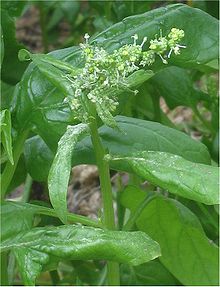Spinach
| Spinach | |
|---|---|
 |
|
| Spinach in flower | |
| Scientific classification | |
| Kingdom: | Plantae |
| (unranked): | Angiosperms |
| (unranked): | Eudicots |
| (unranked): | Core eudicots |
| Order: | Caryophyllales |
| Family: | Amaranthaceae, formerly Chenopodiaceae[2] |
| Subfamily: | Chenopodioideae |
| Genus: | Spinacia |
| Species: | S. oleracea |
| Binomial name | |
|
Spinacia oleracea L. |
|
| Nutritional value per 100 g (3.5 oz) | |
|---|---|
| Energy | 97 kJ (23 kcal) |
|
3.6 g
|
|
| Sugars | 0.4 g |
| Dietary fiber | 2.2 g |
|
0.4 g
|
|
|
2.9 g
|
|
| Vitamins | |
| Vitamin A equiv. |
(59%)
469 μg
(52%)
5626 μg12198 μg
|
| Vitamin A | 9377 IU |
| Thiamine (B1) |
(7%)
0.078 mg |
| Riboflavin (B2) |
(16%)
0.189 mg |
| Niacin (B3) |
(5%)
0.724 mg |
| Vitamin B6 |
(15%)
0.195 mg |
| Folate (B9) |
(49%)
194 μg |
| Vitamin C |
(34%)
28 mg |
| Vitamin E |
(13%)
2 mg |
| Vitamin K |
(460%)
483 μg |
| Minerals | |
| Calcium |
(10%)
99 mg |
| Iron |
(21%)
2.71 mg |
| Magnesium |
(22%)
79 mg |
| Manganese |
(43%)
0.897 mg |
| Phosphorus |
(7%)
49 mg |
| Potassium |
(12%)
558 mg |
| Sodium |
(5%)
79 mg |
| Zinc |
(6%)
0.53 mg |
| Other constituents | |
| Water | 91.4 g |
|
|
|
|
|
| Percentages are roughly approximated using US recommendations for adults. Source: USDA Nutrient Database |
|
Spinach (Spinacia oleracea) is an edible flowering plant in the family Amaranthaceae native to central and western Asia. Its leaves are eaten as a vegetable.
It is an annual plant (rarely biennial) growing to 30 cm (12 in) tall. Spinach may survive over winter in temperate regions. The leaves are alternate, simple, ovate to triangular, and very variable in size from about 2–30 cm (1–12 in) long and 1–15 cm (0.4–5.9 in) broad, with larger leaves at the base of the plant and small leaves higher on the flowering stem. The flowers are inconspicuous, yellow-green, 3–4 mm (0.1–0.2 in) in diameter, maturing into a small, hard, dry, lumpy fruit cluster 5–10 mm (0.2–0.4 in) across containing several seeds.
Common spinach, S. oleracea, was long considered to be in the family Chenopodiaceae, but in 2003, that family was merged into the family Amaranthaceae in the order Caryophyllales. Within the family Amaranthaceae sensu lato, Spinach belongs to subfamily Chenopodioideae.
The English word "spinach" dates to the late 14th century, and is from espinache (Fr. épinard), of uncertain origin. The traditional view derives it from O.Prov. espinarc, which perhaps is via Catalan espinac, from Andalusian Arabic اسبيناخ asbīnākh, from Arabic السبانخ al-sabānikh, from Persian اسپاناخ aspānākh, meaning purportedly 'green hand', but the multiplicity of forms makes the theory doubtful.
...
Wikipedia
